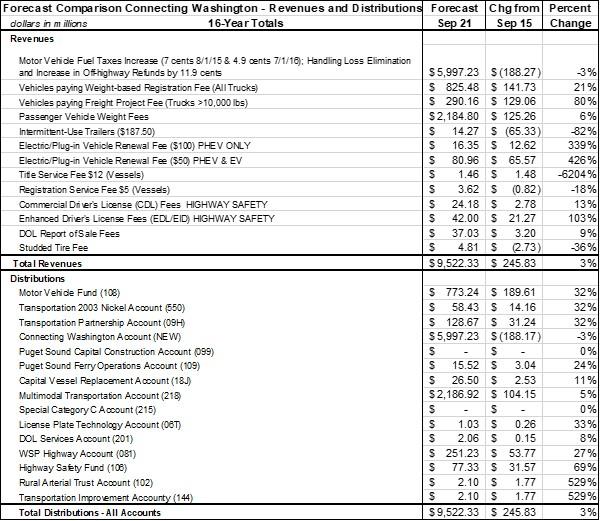Connecting Washington
See details on the 2015 Connecting Washington funding package, a $16 billion investment that enhances the statewide transportation system and maintains critical infrastructure.
Connecting Washington is a 16-year program, funded primarily by an 11.9-cent gas tax increase that was fully phased-in on July 1, 2016. Only the increase in the fuel tax was distributed to the CW account while other fee increases in the Connecting Washington revenue package were distributed to other transportation accounts. Some of the new or increased fees in the CW revenue package included the following: light truck combined license fees, vehicle passenger weight fees, freight project fee, intermittent-use trailer fee, electric vehicle renewal fees and title and registration fees on vessels.
The CW revenue package continued a commitment to walking, biking, transit and other public transportation options by having the largest fee increase, passenger vehicle weight fee, continue to be deposited into the multimodal account.
Program benefits
Connecting Washington funding is distributed to projects that help preserve our state’s highway system and reduce congestion in the central Puget Sound area. Program funding also improves freight transportation reliability across Snoqualmie Pass and strengthens transportation to national and international markets. Funding supports non-highway projects like ferries and terminals, rail, transit, bicycle, and pedestrian facilities. Critical bridge needs and fish habitat expansion through barrier removal at highway crossings are also funded by the Connecting Washington Program. The anticipated cost savings over the years of the program will be used to fund preservation and unforeseen projects.
Below is a comparison of the original revenue forecast in Sept. 2015 compared to the September 2021 forecast six years later for the CW state taxes and fees which were new or increased. In total the CW transportation revenue increases were $9.52 billion over the 16-year totals which was $245 million higher than the original projections. The primary sources of the forecast increase over the past six years were in the passenger vehicle weight fees, freight project fees and truck weight fees which all come in higher. The fuel tax increases contained in the CW funding package are lower than in the past due to the recent pandemic and the anticipated slow recovery.

Multimodal solutions
The Connecting Washington program supports many different kinds of transportation options, like transit and ferries, by:
- Authorizing voter-approved Sound Transit Light Rail expansion.
- Authorizing Snohomish County to impose an additional voter-approved 0.3 percent sales and use tax for community transit.
- Allowing public transportation benefit areas to establish passenger-only ferry service districts with independent taxing, spending and bonding authority.
- Allowing transportation benefit districts to levy a $50 vehicle fee for roads and transit.
Project information
At a high level, the Connecting Washington program funds a number of important projects around the state:
- $1.9 billion: SR 167/SR 509 Gateway project.
- $1.6 billion: SR 520 "Rest of the West".
- $1.3 billion: I-405 Lynnwood to Tukwila Corridor Improvements.
- $879 million: US 395 North Spokane Corridor.
- $494 million: JBLM Congestion Relief Project.
- $426 million: I-90 Snoqualmie Pass.
- $335 million: Safety projects including I-90/SR 18 interchange, US 2, SR 20 and others.
Use the Connecting Washington interactive map to learn more about projects near you.
Slow down on ice and snow.
It's easier to skid or lose control traveling at higher speeds. Give yourself more time to stop.
Carry chains, practice installing them.
Winter conditions could mean chains are required on your route. Practice putting them on your vehicle ahead of time.
Pack your winter car kit.
Carry extra supplies like warm clothing, ice scraper and brush, jumper cables and other emergency items.
